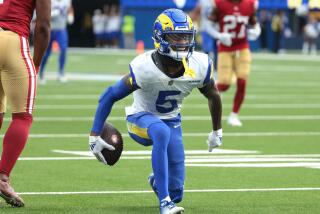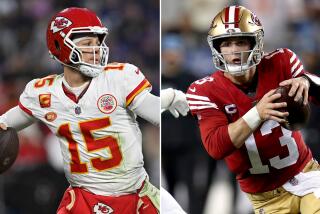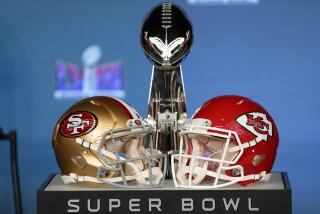Why Bears could run it up on Colts
- Share via
The Indianapolis Colts’ defense is built on speed; the Chicago Bears’ offense is constructed around power.
Playing conditions at Dolphin Stadium -- which has a Prescription Athletic Turf draining system for its natural grass in case of rain -- is not expected to be a factor, so whichever unit wins this battle will probably control today’s Super Bowl.
Indianapolis’ defense features a standard 4-3 set with two safeties deep, but it’s how the Colts utilize their quickness that has made their coverage special in these playoffs.
Linebackers Gary Brackett and Cato June are two of the NFL’s quickest at their position and are the leading tacklers on the team. Along with veteran Rob Morris, who has played well since moving from the middle to the outside at midseason, they were all over the field making tackles in victories over Kansas City, Baltimore and New England.
Cornerbacks Nick Harper -- who may not play because of an ankle injury -- Jason David and Marlin Jackson did a solid job guarding the flat areas on pass plays, and safeties Bob Sanders and Antoine Bethea helped out with run support and provided deep pass coverage.
Everything started with the Colts’ defensive front, which dominated behind energetic ends Dwight Freeney and Robert Mathis. On every play, Indianapolis attacked the line of scrimmage, with interior players Anthony McFarland and Raheem Brock getting good push in the middle.
But the Colts benefited from playing two of their three playoff games inside the RCA Dome, where speed is enhanced over the artificial surface.
During the season, Indianapolis’ defense was a much different unit on grass than turf. The Colts had fewer sacks -- 0.4 to 2.1 -- and forced fumbles -- 0.6 to 1.2 -- per game when they played outside on grass compared to games played on turf.
Freeney, one of the best pass rushers in the league, had 0.5 sacks in five games on grass compared to 5.0 on turf. Mathis had 8.5 of his team-leading 9.5 sacks on turf.
The Colts rely heavily on their defensive linemen to create pressure on the quarterback without the help of blitzing linebackers or defensive backs. They will have their work cut out against a solid Chicago offensive line.
In the Bears’ home playoff victories over Seattle and New Orleans, they rode their line’s power blocking on the sloppy grass of Soldier Field. It was difficult for the Seahawks and Saints to utilize any speed rushes and Chicago’s big and mobile linemen controlled up front.
A favorite play of the Bears is a power run from an “I” formation, with running backs Thomas Jones or Cedric Benson behind center Olin Kreutz and right guard Roberto Garza. Left guard Ruben Brown pulls and provides a lead with fullback Jason McKie, and right tackle Fred Miller and tight end Desmond Clark clean up the rest with drive blocks. It’s the type of play Chicago will feature in an attempt to wear down the Colts, who will be in trouble if they give up runs inside the tackles.
Summary: If footing becomes any problem at all because of weather, the advantage goes to the Bears’ offense, which has excelled in bad-weather home playoff games.
But even if the conditions are not in their favor, the Bears play a style of offense that can give Indianapolis problems. Chicago practices against a similar defense every day and should be familiar with the schemes used by the Colts.
*
More to Read
Go beyond the scoreboard
Get the latest on L.A.'s teams in the daily Sports Report newsletter.
You may occasionally receive promotional content from the Los Angeles Times.










